Seto is not just a place for pottery, but is also home to a variety of other tsukuri-te activities. This time we will be introducing "SETO TOTEMPOLE," made from thinned wood from Seto. The totem pole, with its somewhat silly expression, is so cute it will grab your heart.

Iwai of Tsukuri-te is primarily a shop manager and buyer at a secondhand clothing store. While purchasing goods in North America, including the US and Canada, once every few months, he came across totem poles, and after collecting them for over 15 years, he fell in love with them so much that he finally decided to make one.
I heard that he makes his products in a corner of his home, so I decided to drop in and talk to him.
A home and workshop filled with the love of totem poles
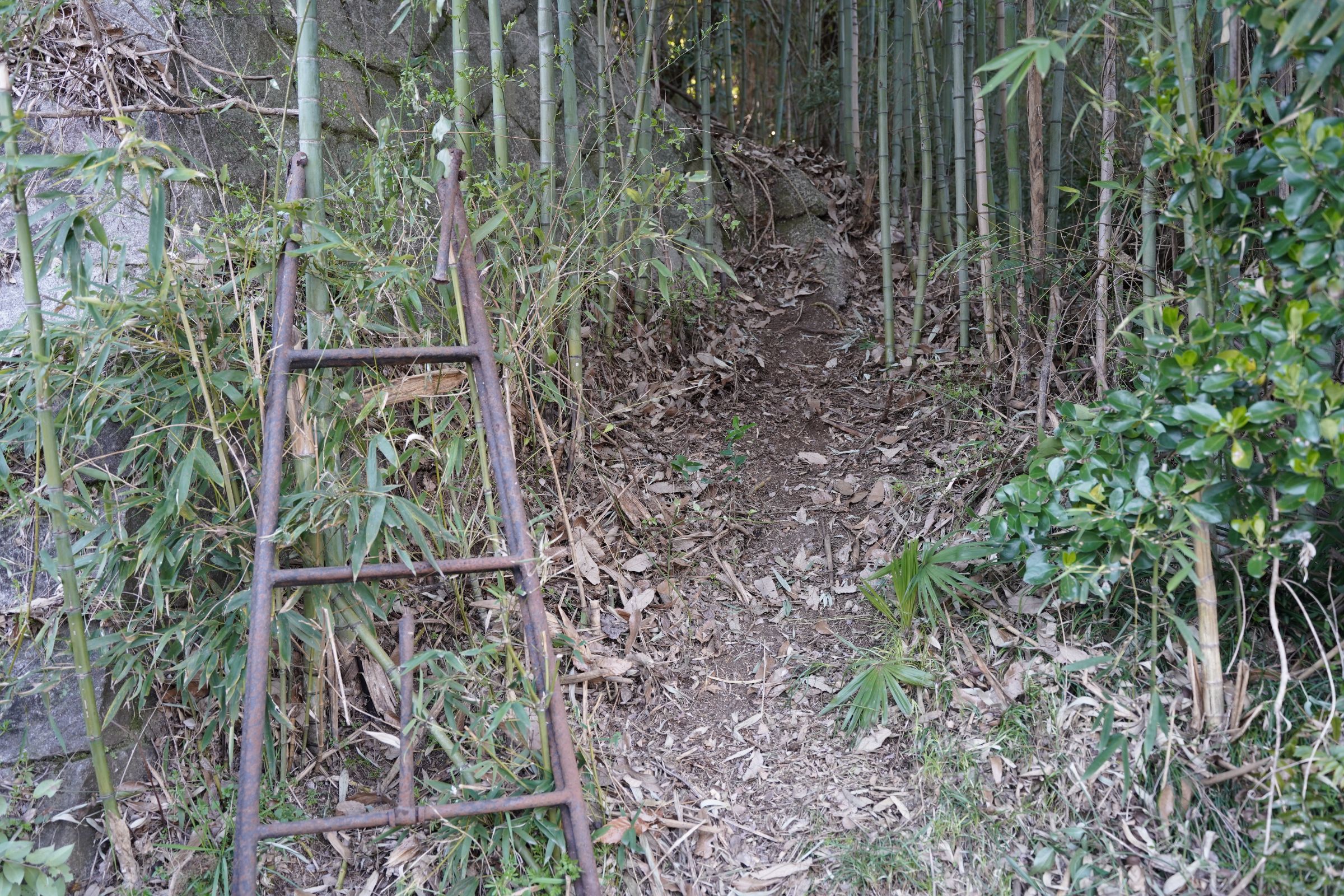
A detailed map arrived for the meeting place, but for some reason there was no address.
I got lost, wondering if it was somewhere around here, but when I finally arrived at the meeting point, Iwai-san and his two children waved to us.
I was told to park my car there, and there was a bamboo grove to the side. I was led up the mountain path in a natural way, and I followed, pretending to be calm. Soon the view opened up, and I arrived at my home and workshop, bathed in sunlight.

Photo: The chicken coop at home. Handmade by Iwai. In the back, there is a large stock of firewood for the wood stove.
I thought he always entered and exited through this entrance, but the main entrance was completely separate. Seeing Iwai-san's smiling face as he said, "I wanted you to come through here," I got the impression that he has a playful personality, and perhaps a very strong sense of "I love this!"
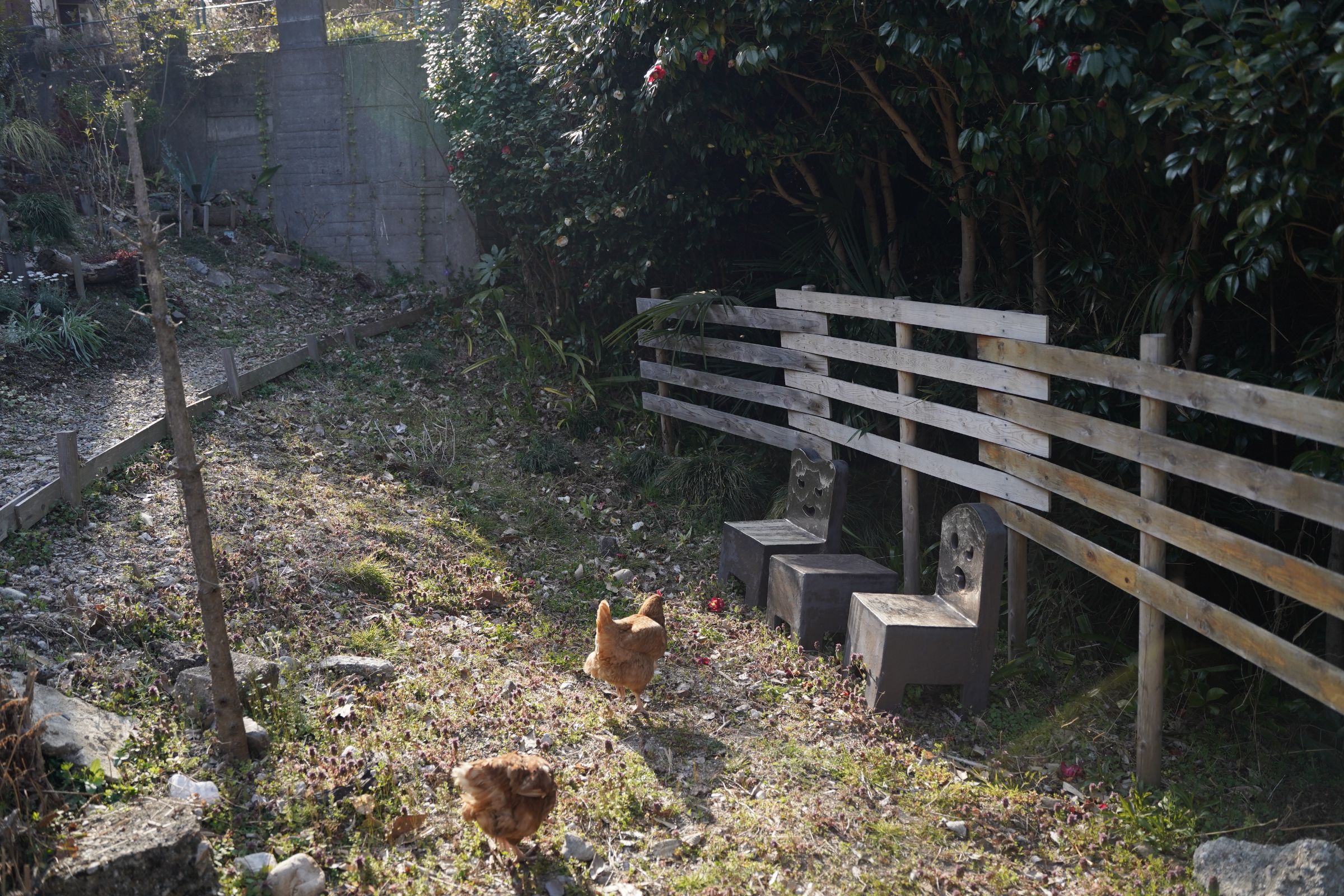
In the garden, there was a chicken coop that Iwai had made himself and he kept two chickens. Their names were Kinako and Anko. When we opened the coop, the chickens came out happily and ran around the garden freely.
Encounter with Totem Pole
When we visited their home, we saw totem poles in the entrance, living room, hallway, and various rooms, as well as folk art from around the world scattered throughout. Their love for art is clearly evident.
Totem poles are carved pillars erected by the indigenous people who lived along the northwest coast of America. They had a unique clan system, and carved animals that symbolized each clan to communicate the identity of the family they lived in, record events, and act as an alternative form of expression to writing. They are important relics that convey their history and culture. However, one day, Iwai came across a totem pole with a "slightly playful" feel at a flea market in America.
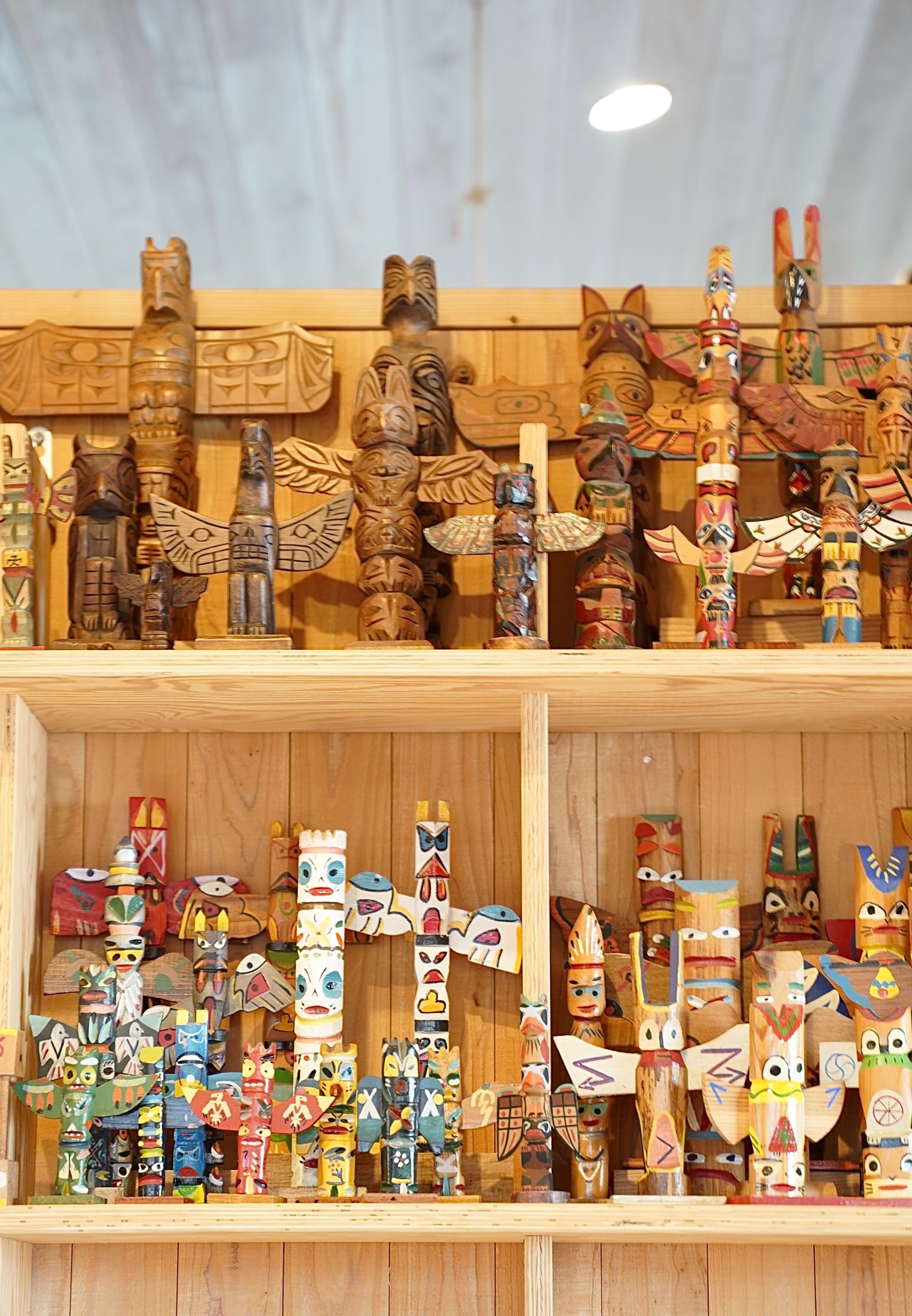
Photo: Iwai says he was shocked by the poorly made totem pole in the bottom right of the photo.
"I was also intrigued by the way the local people loved these cheap totem poles, and how the old men cherished them. I felt a sense of familiarity with them, like with traditional Japanese toys, and as I researched the origins of totem poles, I discovered that they had many things in common with Japan, and I became more and more fascinated."
From collector to creator
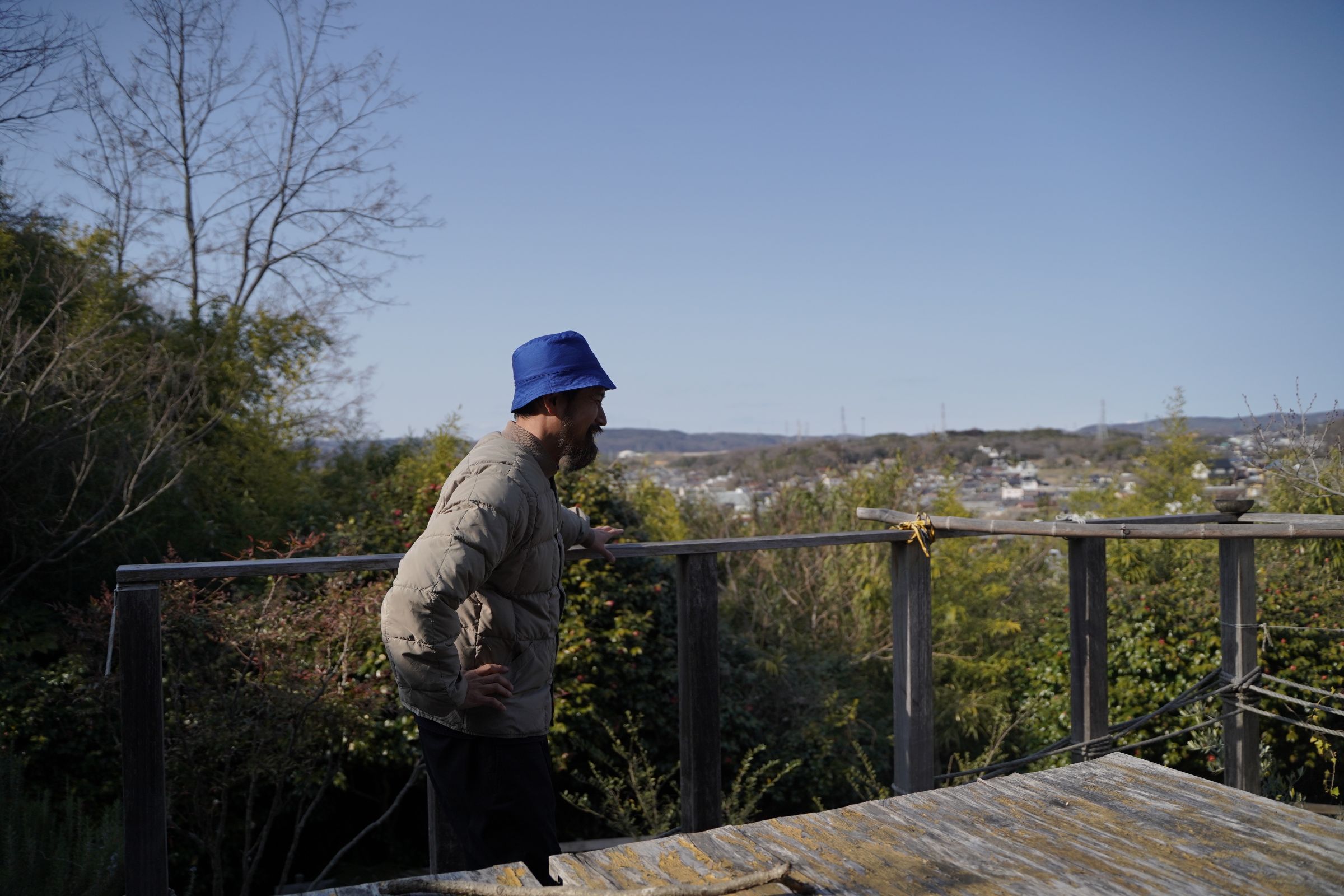
Photo: The terrace with a great view. This was the deciding factor in deciding on the property.
It was by chance that Iwai started making his own totem poles. Having sent his child to a forest kindergarten in the neighboring city of Nagakute in Aichi, he wanted to have a home in the middle of nature, and while searching for a house near Nagoya, he found a house in Seto. He moved there about five years ago and has been living there with his family of four ever since.
The property came with a wood-burning stove, so naturally, they adopted a wood-burning stove lifestyle. They had no trouble gathering firewood. Seto is a pottery town, and when climbing kilns were used, a large amount of red pine was used as firewood, so now there is a surplus, to the point that forest management is necessary.
They joined the Forest Thinning Association, established by Forestonia, a landscaping company in Seto City, and have been maintaining the forest and receiving thinned trees in return. When the elementary school closes, they also go to collect the trees when they are cut down.
"Opportunities to obtain firewood increased, and I was able to gather wood. I thought I'd try making something myself using that wood, and that's how it all began."
At first, I made totem poles to give as gifts to friends or to decorate my home. The first time I showed them off to others was at Matsuchiyokan, an old folk-style gallery in a shopping district that I had always noticed while walking around.
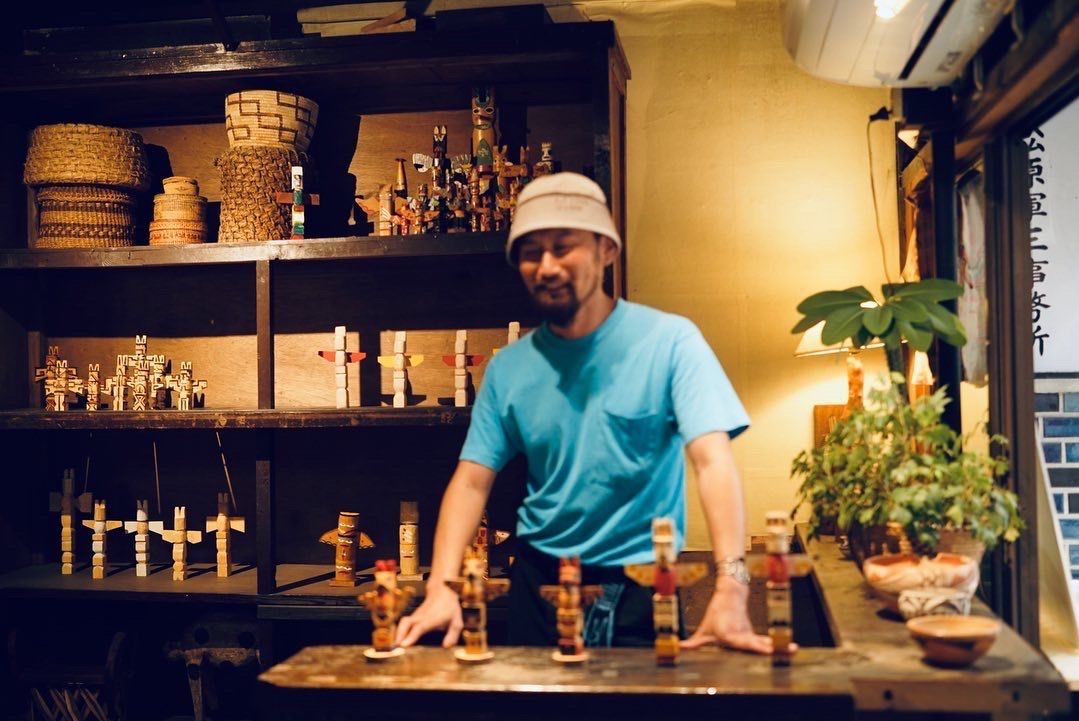
Photo: The first event held at Matsuchiyokan in October 2022.
At that time, a senior acquaintance introduced me to him on Instagram, and a buyer from Hibiya Central Market who had seen the post contacted me, and so this unknown newcomer ended up holding a 10-day solo exhibition at Tokyo Midtown Hibiya.
Around the same time, the editor-in-chief of ONKLE contacted him and they decided to create original Scandinavian-style products for the Scandinavian special feature. Having previously visited Finland with his family for a month, he created the products inspired by the birds he saw in Scandinavia.

With such a wide range of work, orders and requests for solo exhibitions have been pouring in one after another, and recently he has been making pieces every day before going to work.
Why build a totem pole?
Mr. Iwai loves totem poles and has the following thoughts at the heart of his creations.
"I'm learning about how my beloved indigenous people coexist with nature and how people should behave in their small communities, and I'm making this with the hope that people today will think about these things too."
It was clear to me that he must have made the effort to move to Seto and live there as a person who puts this idea into practice.
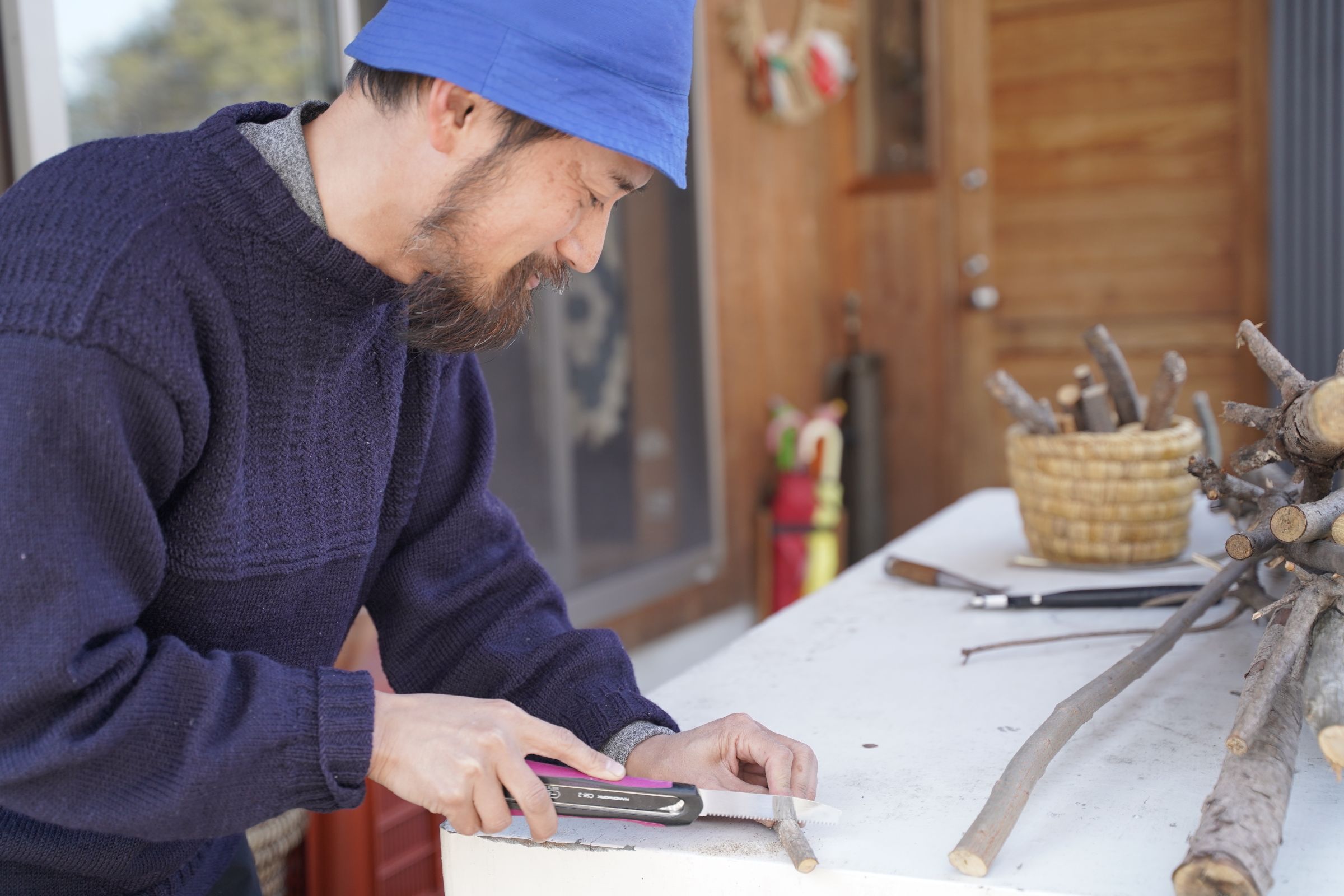
Here we will show you how to make it. First, prepare a thin branch of wood and cut it with a small saw.
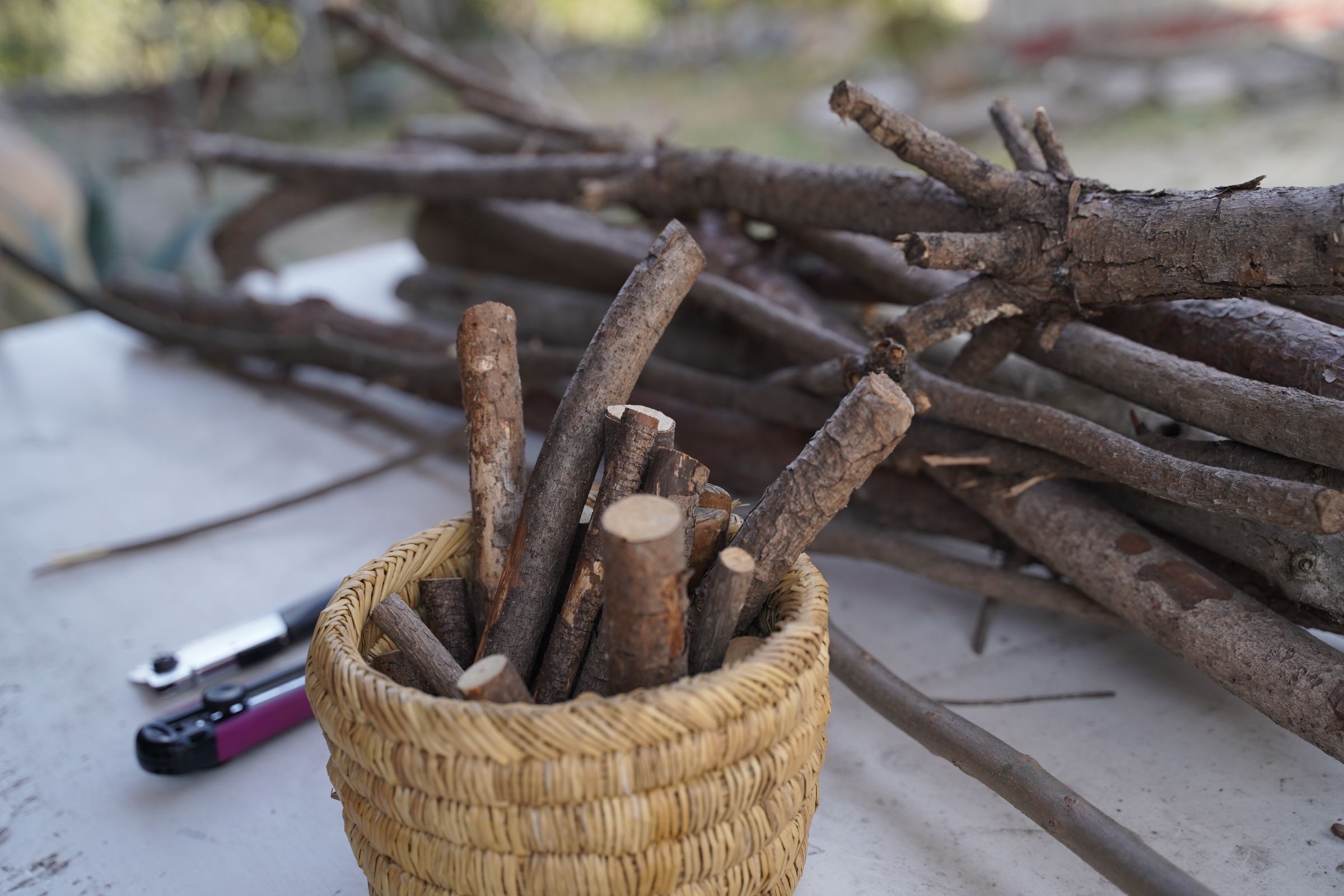
Once cut to the right size, about 20cm, it is carved using a chisel.
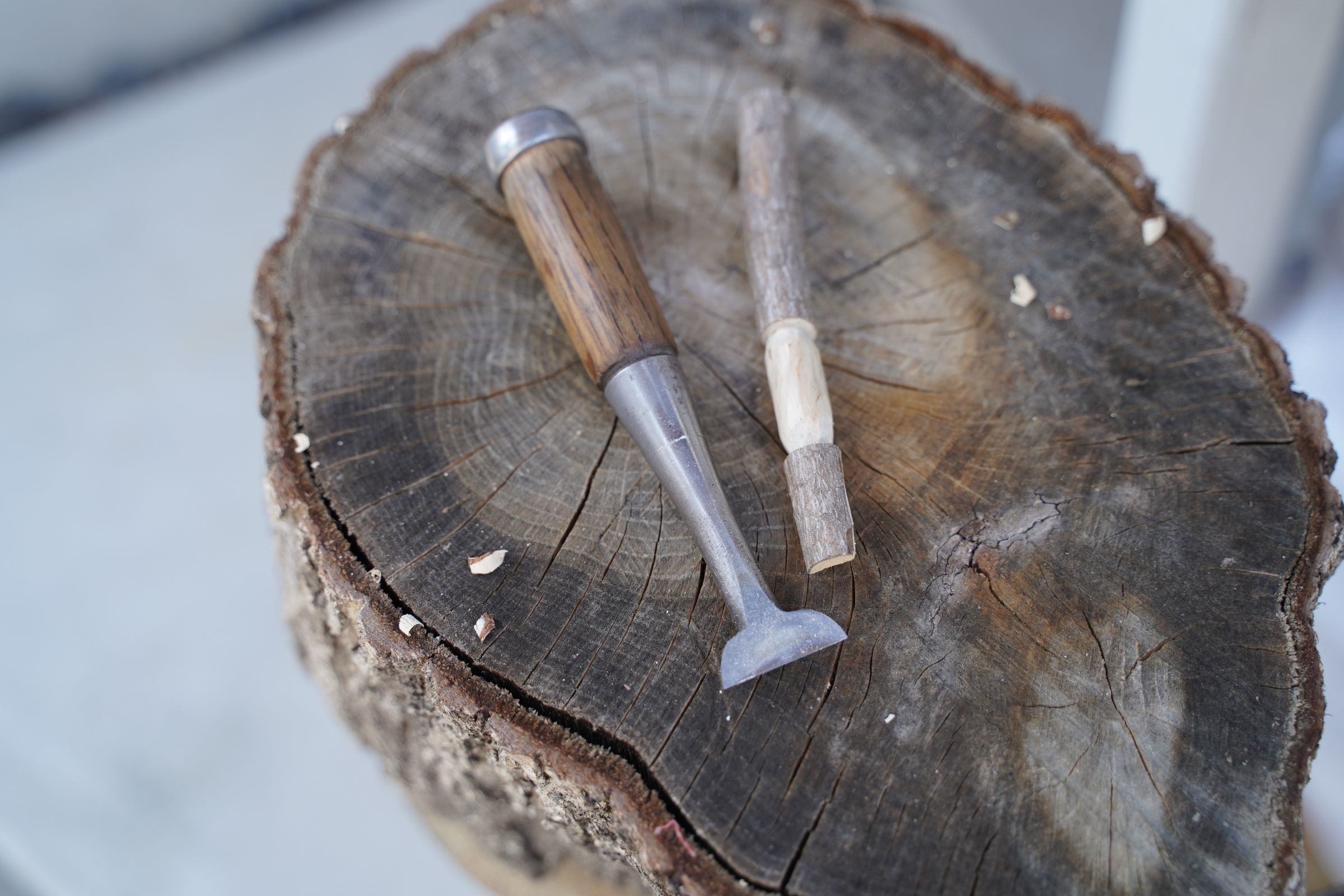
The only tool he uses is this chisel, which he bought at an antique market. After trying out various types, he found this one to be the easiest to use and makes his cuts with a size that can be easily shaved.
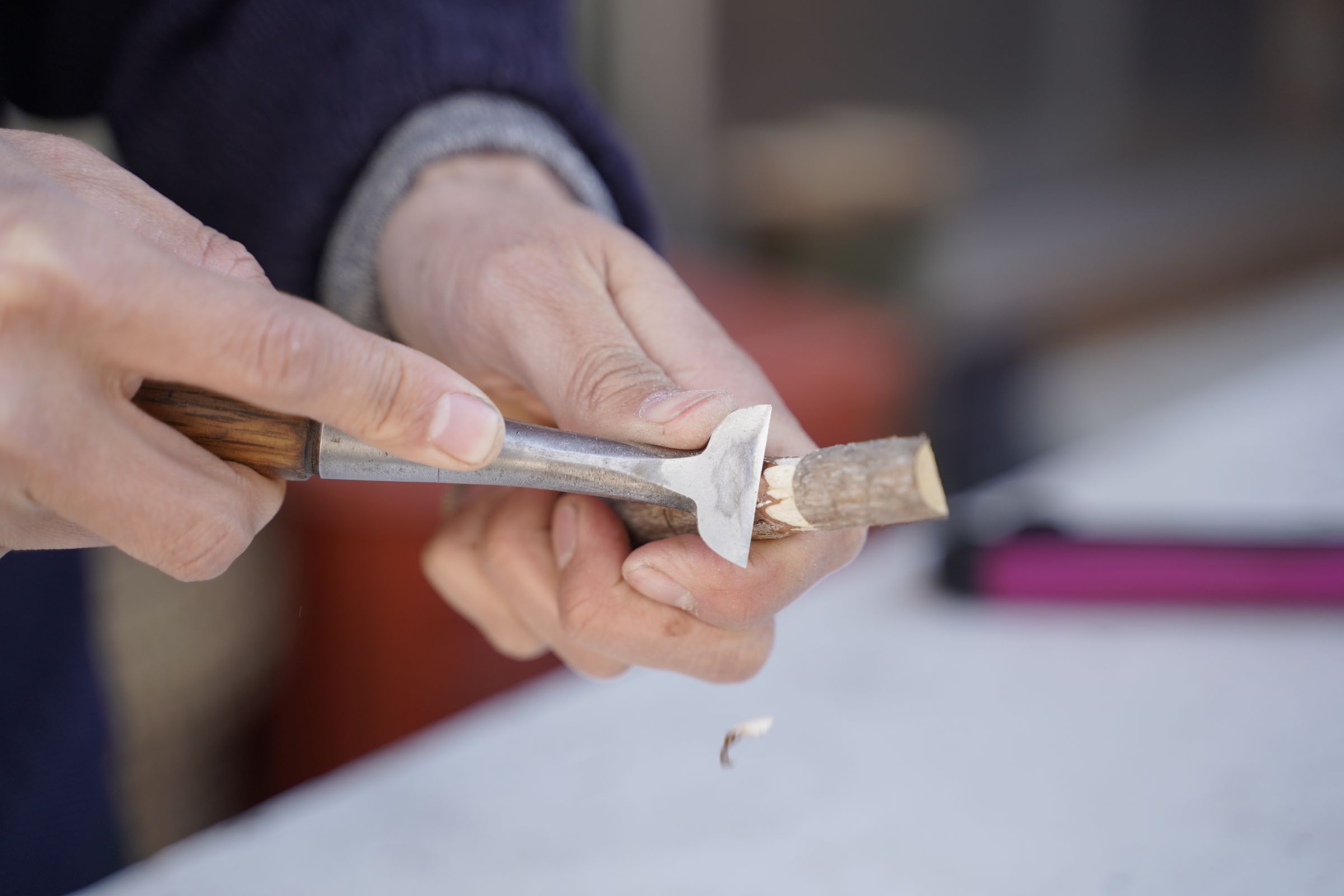
As you carve it as usual, the shape will gradually emerge. You carve it roughly outside, and then at home you carve it in more detail and add color.
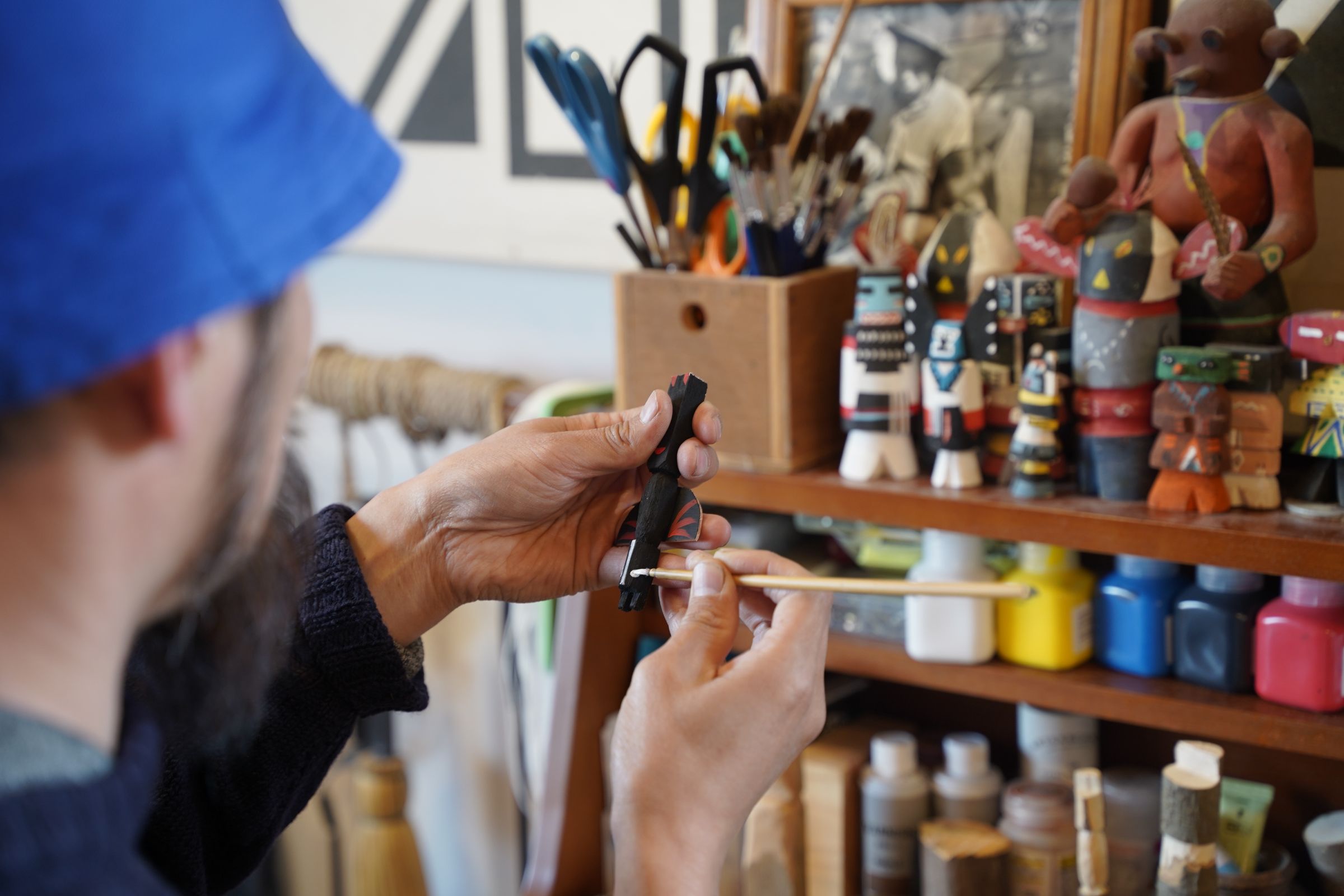
Iwai has a long history of collecting totem poles, so when he looks at the expression of the tree, he gets an idea of what he should do with it.
"I've never done a draft, and when I paint or draw, everything is done in one go. I've been collecting all kinds of things for so long that I have a clear idea of what I like and what I don't like, so maybe that's why I don't have any doubts. I also value whether I can grow attached to them. I like their faces to have a bit of cuteness to them. I value their poor craftsmanship, but not their lovable side (laughs)."
Totem poles as souvenirs from Seto
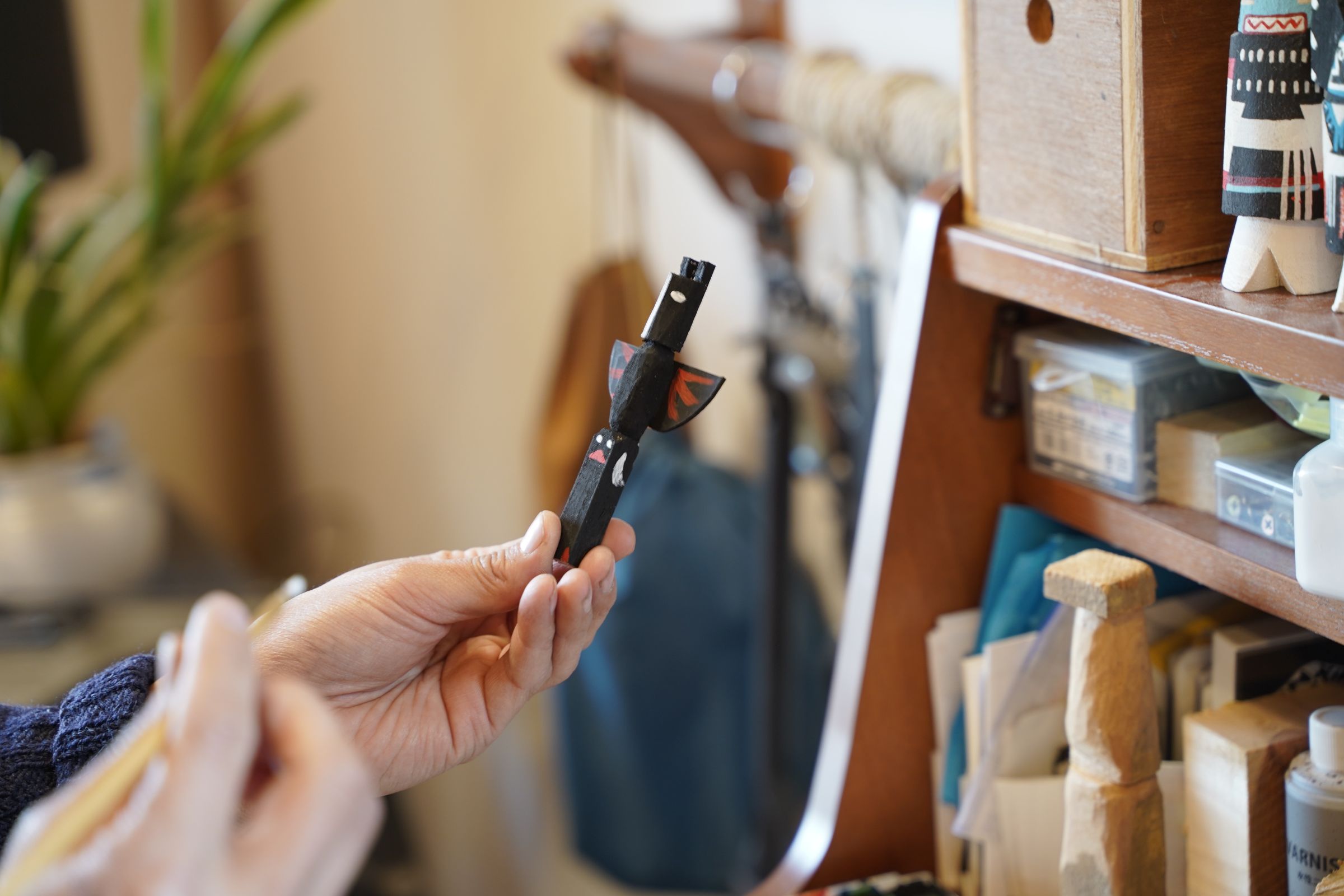
Photo: "I like the colors of Japanese folk toys, which are calming for Japanese people."
Mr. Iwai has been making these totem poles as a souvenir from Seto since the beginning. We asked him why.

"Originally, I had no intention of doing art. I just liked folk crafts. I love traveling, it cleanses the soul. It's fun, isn't it? I think souvenirs are connected to travel.
The goal of making these totem poles is to attract people to Seto. When we hold events, unusual people come from other prefectures, and it feels like there's a certain excitement when totem poles are used for events. I thought that if that could happen, it would be the most rewarding thing, so I started this project."
He says he was happy that people who visited Seto for a previous solo exhibition enjoyed it so much.
"Even without me suggesting anything, they often take photos there, or go down little paths and enjoy themselves.
The people who come to see my work, as well as those who suddenly invite me to a solo exhibition, are generally a little bit crazy (laughs). But I feel that people who can do that have the power to make the town more interesting, and that they can make Japan a better place, so I make things to sell outside of Seto."
Aiming to create "neo-local toys" that are fun to make and contribute to the local community

"I've never wanted to be a craftsman, and I'm not an artist. I think it's fine if it's something that anyone can do. Japanese folk toys and Buddha statues are a world that seems too intimidating, so even if you want to start, it's difficult to get started.
Nowadays, even the things that people finally learn to make after decades of training don't sell very well. I think that if young people today aim for this, they probably won't have a happy future. There are people who say that this Seto Totem Pole is fun, and I want to show children that they are doing something fun like that. We can create fun and contribute to the community. I would be happy if it becomes such a "neo-local toy."
We would like to support "SETO TOTEMPOLE" as a "neo-local toy" that is rooted in Seto.





